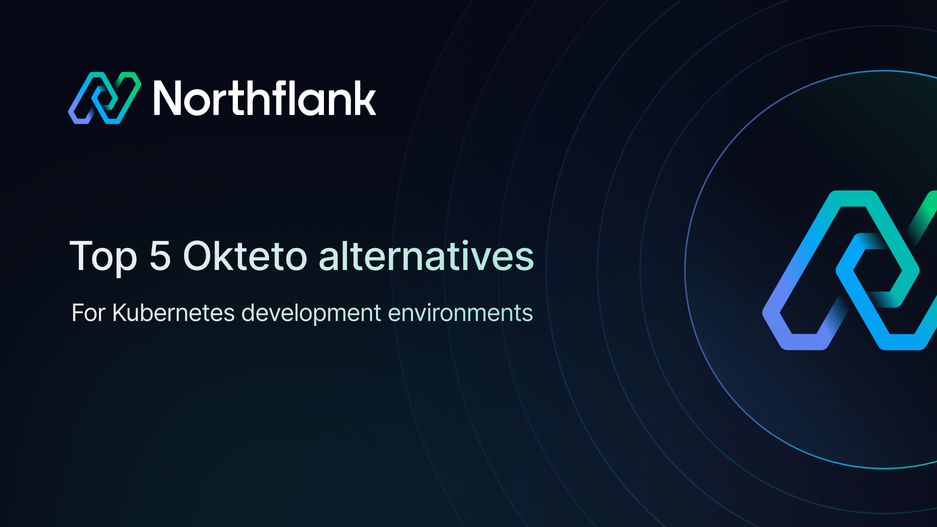

Top 5 Okteto alternatives for Kubernetes development environments in 2025
You're building on Kubernetes, and you need development environments that don't slow your team down with lengthy build cycles or complex setup processes.
Okteto has been a reliable option for teams needing automated development environments with hot reload capabilities, but the platform ecosystem now includes multiple specialized solutions.
This is a technical comparison of five alternatives that solve similar problems, each with different deployment models, integration capabilities, and architectural approaches.
If you're short on time, this is an overview of the platforms covered in this comparison:
- Northflank – Production-ready platform that handles the full application lifecycle from development through production. Built-in features including GitOps, CI/CD, ephemeral preview environments, observability, auto-scaling, and disaster recovery. Deployment flexibility across managed cloud or bring-your-own-cloud (GKE, EKS, AKS, Civo, OKE, bare-metal). Real-time UI with sub-second updates.
- Tilt – Open-source toolkit that automates microservice development workflows. Live updates deploy code to running containers in seconds. Visual UI shows all services, logs, and errors in one view.
- Skaffold – Command-line tool that automates the workflow for building, pushing, and deploying Kubernetes applications. Handles continuous development with optimized local workflows and policy-based image tagging. Works with your existing tools through pluggable architecture.
- Telepresence – Establishes a two-way tunnel between your local machine and remote Kubernetes cluster. Intercepts remote traffic and routes it to your local service for development and testing. Access remote cluster resources as if running locally while using your preferred local tools.
- Bunnyshell – Ephemeral environments platform that creates isolated, production-like environments for every pull request. Integrates with GitHub, GitLab, Bitbucket, Kubernetes, and major cloud providers. Auto-shuts down idle environments to optimize cloud costs.
Before we go into the alternatives, it's worth understanding what problem these tools solve.
Traditional Kubernetes development workflows often force teams into one of these unsatisfactory approaches:
- Local development with tools like Docker Desktop or Minikube, which can't replicate the complexity of production environments
- Build-push-deploy cycles that add 5-10 minutes of wait time for every code change
- Direct testing in shared staging environments, creating bottlenecks and conflicts between developers
Modern Kubernetes development platforms address these challenges by providing ephemeral, production-like environments where developers can test changes in real-time without the overhead of traditional deployment cycles.
Okteto provides automated Kubernetes development environments with real-time code synchronization, reducing typical build cycles from 5-10 minutes to under 3 seconds.
Key Okteto features include:
- Development containers that mirror production configurations
- Hot reload capabilities for instant feedback on code changes
- Preview environments automatically created for pull requests
- Integration with existing Helm charts and Docker Compose files
When evaluating platforms for Kubernetes development environments, focus on these key factors:
-
Deployment model
Does your team need a managed cloud solution, or deployment in your own infrastructure? Platforms like Northflank offer both options through bring-your-own-cloud, while others operate solely as managed services or require self-hosting.
-
Scope of lifecycle management
Determine if you need a platform that handles only development environments or one that manages the complete application lifecycle from development through production. Some alternatives focus exclusively on the development phase, while others provide end-to-end deployment and monitoring capabilities.
-
Integration requirements
Assess how the platform integrates with your existing toolchain. Check compatibility with your CI/CD pipelines, version control systems, monitoring tools, and cloud providers. Open-source tools typically offer more flexibility but may require additional configuration.
-
Team expertise
Assess your team's Kubernetes knowledge. Some platforms abstract away Kubernetes complexity entirely, while others assume familiarity with Kubernetes concepts and provide more direct cluster access.
-
Preview environment capabilities
If preview environments for pull requests are critical to your workflow, examine how each platform handles environment provisioning, teardown automation, database handling, and secrets management.
-
Cost structure
Look at both platform costs and underlying infrastructure expenses. Review pricing models (per-user, per-environment, compute-based) and features like automatic resource scaling and idle environment shutdown that can reduce cloud costs.
-
Scale and performance
Determine if the platform can handle your team size and deployment frequency. Look at factors like build speed, environment startup time, and support for concurrent environments.
Let’s see the five platforms in more detail that address similar Kubernetes development challenges, each with distinct approaches to deployment, developer experience, and infrastructure management.
Northflank is a comprehensive developer platform that extends beyond development environments to handle your entire application lifecycle from development through production.
What sets Northflank apart:
- Full lifecycle management: Unlike Okteto's focus on development and preview environments, Northflank manages production deployments, auto-scaling, observability, and disaster recovery. This means one platform for your entire workflow rather than piecing together multiple tools.
- Deployment flexibility: Deploy to Northflank's managed cloud for instant setup, or connect your own infrastructure (GKE, EKS, AKS, Civo, OKE, bare-metal) while maintaining the same platform experience and features.
- Built-in features: GitOps workflows, CI/CD pipelines, ephemeral preview environments with automated teardown, secrets management, and real-time observability come standard without additional integrations.
- Real-time interface: Sub-second UI updates provide instant feedback on deployments, builds, and system state across all environments.
Best for: Teams needing a production-ready platform that scales from development to production without switching tools. Particularly suited for organizations requiring multi-cloud flexibility, enterprise security controls, or teams that want to move beyond development-only tooling.
Try Northflank's free developer sandbox, review pricing plans, or book a demo with an engineer to discuss your team's specific requirements.
Tilt is an open-source toolkit that automates microservice development workflows by watching files, building container images, and updating your environment automatically.
Key capabilities:
- Live updates: Deploys code to running containers in seconds, even for compiled languages or dependency changes, removing the build-push-deploy cycle during development.
- Visual UI: Shows all services, logs, broken builds, and runtime errors in a single view, giving you visibility across your entire microservices architecture.
- Pluggable architecture: Works with your existing tools and workflows. Integrates seamlessly with Helm, Docker, and Kubernetes without requiring changes to your deployment setup.
Best for: Teams working with complex microservices architectures who need fast feedback loops and visibility into multiple interdependent services running simultaneously.
Skaffold is a command-line tool that automates the workflow for building, pushing, and deploying Kubernetes applications with optimized local workflows and policy-based image tagging.
Key capabilities:
- Pluggable architecture: Supports multiple build systems (Docker, Jib, Bazel, Buildpacks) and deployment tools (kubectl, Helm, kustomize).
- Automated workflow: Detects source code changes and handles the pipeline to build, push, test, and deploy automatically.
- Client-side only: No cluster-side component means zero overhead on your Kubernetes cluster. Fully open-source and maintained by Google.
Best for: Teams that want simple automation for their existing Kubernetes workflows without adopting a full platform.
Telepresence establishes a two-way tunnel between your local machine and remote Kubernetes cluster, routing remote traffic to your local service for development and testing.
Key capabilities:
- Local development with remote access: Run your service locally while accessing remote cluster resources as if your laptop is part of the cluster.
- Traffic interception: Routes specific cluster requests to your local machine for testing without deploying.
- Use your local tools: Work with your preferred IDE, debugger, and profiler while connected to the remote cluster.
Best for: Teams that want to preserve local development workflows while testing integration with remote services.
Bunnyshell creates isolated, production-like environments for every pull request with AI-assisted setup and automated provisioning.
Key capabilities:
- Ephemeral environments: Automatically provisions isolated environments for each PR. Auto-shuts down idle environments to optimize cloud costs.
- Multi-cloud integration: Works with GitHub, GitLab, Bitbucket, Kubernetes, Docker, and all major cloud providers.
- Reusable templates: Create standardized environment configurations that can be shared across teams.
Best for: Teams needing multi-cloud flexibility and automated cost optimization through ephemeral infrastructure.
Each platform addresses different aspects of the Kubernetes development workflow, from full lifecycle management to specialized tooling for specific use cases.
| Platform | Choose if you need |
|---|---|
| Northflank | • Production-ready platform managing the full application lifecycle (dev → staging → production) • Deployment flexibility with managed cloud or bring-your-own-cloud options • Built-in CI/CD, preview environments, observability, and disaster recovery without piecing together multiple tools • Enterprise security and compliance requirements |
| Tilt | • Fast feedback loops for complex microservices architectures • Visual dashboard showing all services, logs, and errors in one view • Willing to write and maintain Tiltfile configurations (Starlark-based) for customized workflows |
| Skaffold | • Lightweight, open-source automation without platform dependencies • Existing Kubernetes expertise on your team • Integration with current workflows and tooling rather than adopting a new platform |
| Telepresence | • Local development workflows while accessing remote cluster resources • Gradual transition from local development to Kubernetes • Testing service integration without full environment replication |
| Bunnyshell | • Multi-cloud flexibility and automated cost optimization • Ephemeral environments for every PR with automatic teardown • Reusable environment templates across multiple teams |
The Kubernetes development tooling ecosystem offers multiple approaches to solving developer productivity challenges, from lightweight open-source CLIs to comprehensive platforms managing full application lifecycles.
Your choice depends on your team's specific needs, expertise level, and infrastructure strategy.
Teams needing only development environments may find focused tools sufficient, while those requiring end-to-end lifecycle management from development through production benefit from platforms like Northflank that consolidate multiple tools into one solution.
Try Northflank's free developer sandbox, review pricing plans, or book a demo with an engineer to discuss your team's specific requirements.